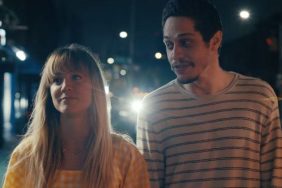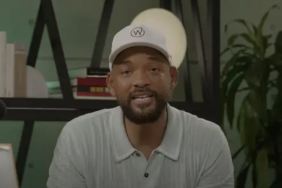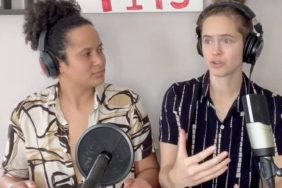Pete Docter is the director who makes you cry, and he’s rather proud of that. His 2009 film Up reduced audiences to tears in the first few minutes, as it detailed the life of a happy couple and watched them wither due to the natural passage of time. And his latest, Inside Out, takes you deep inside the mind of a troubled child as her emotions run amok, threatening to plunge her into insanity when both Joy (voiced by Amy Poehler) and Sadness (voiced by Phyllis Smith) get lost inside her memories.
We sat down with Pete Docter to talk about the deeper ramifications of his story, and ask why the protagonist’s head is full of emotions but completely devoid of logic. We also ponder the finer points of Floam and the history of Pixar, dispelling popular myths about the studio and offering new and very unusual advice for artists of all kinds.
Inside Out is currently in theaters everywhere.

CraveOnline: So I cried three times at this movie…
Pete Docter: Oh, thank you.
…you bastard. Why do you keep doing that to us?!
[Laughs.] Can I ask which parts you cried at?
I cried [redacted], which was devastating, and I cried when [redacted], and I cried when [redacted] at the end.
Cool! Thank you.
But seriously, why do you do that to us? You could just make happy little movies and instead you want to devastate the children of America.
Alright, well, here’s some research we found: Memories are much more likely to last with you if they’re emotionally charged. So if you were really angry at somebody or scared by something, bit by a dog when you were three, you still probably remember that. Whereas where you put your car keys yesterday, who knows?
So I always feel like what I’m trying to do is give you the best bang for your buck. If you remember while you’re watching it and then it goes out of your head, then you don’t get a lot of value out of that. If you take it home with you and turn it around, and it gives you something to think about, that’s good!

It’s interesting that you take such a logical approach to emotions, in a movie about emotions controlling us. One of the things – I was talking to my girlfriend about this – but one of the things that was absent was logic. Had you thought about putting something in Riley’s head that was unemotional, as an influence on her behavior?
Yeah, we did. We had an early version where we had Frank, in the head office, and he was always struggling against the ineptitude of all the emotions and wanting to do something. Then they would get mad and throw logic out the window.
Haha!
It seemed funny but where we went with that was then it felt like all of Riley was represented by these characters, so she then became kind of a big robot that they would steer and move. And Joy… the film is kind of sparked from a parent watching their kid grow up, and so we needed a genuine relationship between Joy and Riley. And if she’s a big robot, I guess you might like your car but I don’t think it’s quite the same as loving a child.
It is interesting though, that the emotions control everything Riley does. Riley isn’t a separate entity so much with her own agency. In a way, everyone in the universe in this Inside Out world is “kind of” a robot, aren’t they?
Well, our thought was… I don’t know if this comes across… you don’t choose whether you feel something. You do choose how you then act on it. That’s up to Riley. So Anger takes over, Riley might not choose to act on it. She might suppress it, she might keep it hidden. That’s the part that’s up to you.
But they do have the power to give her a specific idea, though.
Yeah.
Is that just a plot function?
That was just a plot function. It doesn’t really… obviously I don’t think emotions give you specific… well, I mean I guess at some point. The way it was explained to me was emotions are kind of in a way our surrogate for instinct. We don’t have instincts the way like a bird will know how to build a nest. Humans don’t have that.
But we do have these emotions that are sort of planted or written at a very early age, and sometimes the script, if you think of it that way, that you speak to your father about, might then be applied to the way you speak to your boss. And you might then unfairly infer certain things on your boss that are really about your dad. These kind of things that get really interesting, very deep.

On a slightly different note, I was having a conversation with someone a few moments ago and we were having a disagreement about this film over who the protagonist was. Because I saw this film and thought that… obviously, it’s Riley, but we’re in her head.
Right.
I thought the protagonist was Sadness, and he thought the protagonist was Joy. What are your thoughts on that?
Definitely Joy. If you think of it in terms of story math, the character who changes the most is your protagonist. So Joy at the beginning does not understand the use of Sadness. She doesn’t know why she’d want her kid to be sad at all. In the end [she] understands, in order to really reconnect with her parents and the thing that means the most to her, that’s going to make her ultimately the most happy, she needs Sadness. So she does a complete 180.
So it may be a semantics argument. In my head the “hero” is Sadness because she’s just trying to do her job.
Yeah.
And Joy is her antagonist to me.
That’s true. Yeah, I mean what’s fun to me about this one is that there’s no bad guy. Joy is kind of the bad guy if you look at it that way.
That’s how I was looking at it. She means well, as all the best bad guys do, I think. But she’s also holding Riley back.
Yeah, and Sadness, I think even at the beginning if you could somehow stop the movie and say, “What’s going on?” I think Sadness would somehow stumble out that she feels Riley needs to feel sad. So she’s the most advanced character of anybody. She kind of knows the right thing to do even in Act One. It’s not until Act Three that she’s able to finally claim that.

Talking about the look of the film: the word I kept thinking about when I was looking at the design of all the emotions was “Floam.”
Hmm!
They all seem to be made of Floam.
That’s a good word.
Are you not familiar with Floam?
No…
Floam is a Nickelodeon toy, it’s like this jumble of moist beads and you can sculpt it.
Oh yeah, I’ve had that before. It’s like styrofoam held together with slime or something like that.
Yeah, you could pull it apart and smash it.
It’s cool.
So tell me about that design.
What we were after was, these are emotions. They shouldn’t look like little people. I’m a fan of The Muppets but they shouldn’t look like little cloth characters either. How can we represent the way our emotions feel to us in some sort of look?
Well, I threw out that challenge and the art/technical group came up with this idea of energy, of these tiny particles that roil and move around. If you look up close, some of them even escape the boundaries of who Joy is, and if she moves fast they get left behind because she’s got so much energy that they trail off. So that was our attempt to represent that, how her emotions feel, in a look.
Tell me about Riley’s imaginary friend, Bing Bong. He isn’t really part of the marketing materials. Are you trying to keep Bing Bong from people?
Well, we were trying to keep him as a surprise. Also, I think out of context he could make the film look like it was for three-year-olds or something, you know? But of course in the film he does represent Riley as a really little kid. In some ways he’s a kind of mirror character to Joy. He believes the same things Joy does, that we should hold onto childhood and keep Riley young and happy to an extreme. He thinks they should go back to age three so he can get his job back. [Laughs.]
I loved at the end that Riley is growing up, and the emotions’ job begins to expand. Pixar obviously doesn’t have qualms against continuing stories with sequels. Is there an idea in your head for Inside Out when she hits puberty, or moves on?
No, no. At this point I’m kind of like, okay, it’s been five years. I’m ready to do something new. [Laughs.]
How new are you thinking? Do you know what you want to do next?
Yeah, I have three ideas, all of which I’m super excited about, which do seem to me to really push the limits of things. I haven’t pitched them to John [Lasseter] or anything yet so we’ll see what goes forward.
I kept hearing about this meeting you guys had early on, where you came up with a lot of your original films, like Toy Story and…
Yeah, that’s largely fictional.
That’s a lie? Is that a little mythbuilding?
[Laughs.] I think what happened was we combined a bunch of different meetings. There was this restaurant in Point Richmond called Hidden City. It was kind of like the cafeteria for the company at that point because we didn’t have one in house. So we would always go there and chew over story things, and so a lot of ideas were born there. And then in the trailer, I think it was for WALL-E, it sort of all got combined. You have a visual with all these, with the tablecloth and we’re drawing on it or something.
That was it. It was a good bit of mythbuilding. I think we all look at Pixar as if it’s some magical company that practically can do no wrong.
That’s false.
You’ve never made a bad film. I didn’t like Cars 2 very much but you seem to do very, very well. Is there a myth you can dispel? Is there something we should know about you guys, to humanize you?
Well, I think it may or may not be widely known, but we almost every film we’ve done has been very bad at one point. It’s just that we don’t show it to you until it ceases to be bad. So we keep working on things and rewriting them and showing them to Lee Unkrich and Brad Bird and getting their thoughts and rewriting it again and trying it again. So I think that’s been a real key for us, is redoing things.

One of the things I’ve seen from Pixar is a list of story rules or guidelines.
Oh yeah, that was kind of interesting.
It’s all really good advice. What I like about that is you’re helping other writers become better. You’re sharing that part of the process.
Right.
Have you ever thought about sharing the part of the process where all these movies stunk? Like, “Here’s the early version of Monsters, Inc. where we hadn’t figured it out yet, and here’s how we figured it out?” in a book or something?
The truth is, people would be so bored and so turned off by that. I don’t think anyone would buy it. We have done it at work for new employees. For new story folks, they come in and we screen and we talk about it. I think they were just doing one last week about [Finding] Nemo. Here’s an early version of Nemo, and then the story crew and anybody who was left from that comes up and talks about what mistakes were made and what we learned and so on.
I always feel like all those sort of lists and rules and things are a great analysis tool when things are broken, but you can’t write a story that way.
I’ve noticed that too. Something like Save the Cat is a good way of looking at a story but when you use it as a blueprint it gets very rigid.
Yeah, totally.
Do you have any other advice? Obviously, “just write,” because that’s the best advice. But is there anything more specific and more interesting that you’ve learned? Because you’re quite good at this by now.
Write and show people. I think that’s [it]. [Thinks.] This is a weird one, but I do feel it’s important to nurture yourself and encourage yourself to be as good a person as you can. It sounds hokey but I feel like ultimately, if you get good at this, it’s almost like a musician. What you put out is going to be a reflection of who you are. So if you’re kind of a selfish, greedy person I don’t think that you’re going to produce great, giving work for other people.
I think you need to work to… That’s easy, and I don’t mean that to be a lecture because I’m a lousy person. I’m still working at being better. But I do think that art in its best form is a reflection of the artist, and so being kind to other people and nurturing a sense of trying to better yourself, I think is a key.








